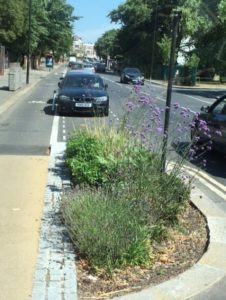Catching the rain from roads to protect our precious groundwater
May 13, 2019
Rainscapes are an innovative and cost-effective way of reducing water pollution caused from highway run-off. Susie Howells, Brighton ChaMP project manager, explains how rainscapes can help protect and improve drinking water supplies in the Brighton chalk aquifer.
When rain falls, water finds its way into the Brighton chalk aquifer – a hugely valuable asset for the region, providing drinking water supplies for around 365,000 people in Brighton, Hove and beyond.
But this precious resource is now under threat. Over many years, nitrate pollution from farming and sewage leaks; chemicals from industry, and pollution from vehicles and urban development have placed increasing pressure on the Brighton Chalk. The upshot of these complex influences is that drinking water quality could now be at risk.
We know the road network has a major part to play in causing pollution. Several studies suggest a significant source of water pollution in the UK is from highway run-off. Brake pads and tyres wear down, cars leak fuel and oil and heavy metals, and hydrocarbons and nitrates are released on to the surface of the road. You can see this when it snows – which quickly turns to black mush as it combines with the pollutants that usually lay unseen on the road. It remains there until the next rainfall, and is then washed into the drainage system – ultimately ending up in our rivers, streams, groundwater and seas. The highest proportion of microplastics in the ocean comes from car tyres.
ChaMP is developing a number of interventions including rainscapes, also known as Sustainable Drainage Systems (SuDS) to clean the polluted water which runs off busy roads, stopping it from getting into soakaways. These soakaways present vulnerable pathways through which urban pollutants can travel into the aquifer.
 Raingardens and rainscapes are shallow planted areas which use natural processes to prevent groundwater pollution by storing and treating polluted water and silts running off the surface of the road. Rainscapes clean the water naturally by slowing and holding water to allow time, sunlight, vegetation and bacteria in the roots of the plants and soil to break down pollutants. Sustainable drainage techniques include swales, bioretention systems, green roofs, permeable paving, tree pits, basins, ponds and wetlands.
Raingardens and rainscapes are shallow planted areas which use natural processes to prevent groundwater pollution by storing and treating polluted water and silts running off the surface of the road. Rainscapes clean the water naturally by slowing and holding water to allow time, sunlight, vegetation and bacteria in the roots of the plants and soil to break down pollutants. Sustainable drainage techniques include swales, bioretention systems, green roofs, permeable paving, tree pits, basins, ponds and wetlands.
They are also excellent for mitigating flooding, and for nature and people: encouraging biodiversity and transforming public space. Through urban walkovers in Source Protection Zones and partnership work ChaMP has identified several sites in Brighton and Lewes for feasibility studies to see if we can develop these schemes locally.
We are pushing groundwater protection in the urban setting up the local and regional agenda with our partners, as well as supporting other organisations’ efforts to create SuDS to ensure groundwater protection is fully considered in new developments, and looking for opportunities to integrate good SuDS design in road schemes.
ChaMP plans to develop the projects to demonstrate SuDS efficiency at removing pollutants with a view to encouraging more rainscapes as a solution to groundwater pollution from busy roads.
For more information on the ChaMP partnership visit https://www.southdowns.gov.uk/care-for/water/brighton-champ-for-water/
